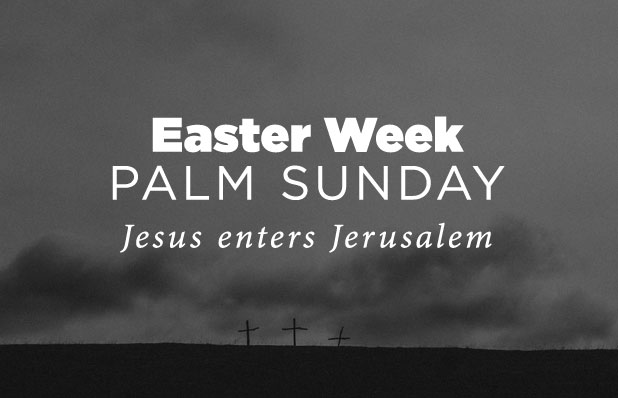
JESUS ENTERS JERUSALEM (March 29, AD 33)
Matt 21:1-11; Mark 11:1-10; Luke 19:28-44; John 12:12-19
Jesus has ministered publically for three and a half years—performing miracles and teaching about his identity as God’s Christ or Messiah meaning spirit-anointed king. Mark’s gospel displays much of Jesus’s ministry in Galilee to the north of Jerusalem where the Messiah had to reveal himself (John 7:3-4). Here, Jesus mounts a donkey to enter Zion as God’s king.
As Jesus and the disciples approached Bethany and Bethpage for Passover week, he sent two disciples ahead to procure a donkey. Bethany was the hometown of Mary, Martha, and Lazarus whom Jesus raised from the dead. Bethpage means house of unripe figs, an interesting name given the discussion of figs throughout this week. The Old Testament often depicts Israel as a fig tree (Jeremiah 8:13; Hosea 9:10, 16; Joel 1-7).
Jesus gave those disciples very explicit instructions—“find a colt tied, on which no one has ever sat” and if anyone asks, “Why are you doing this?” Tell them, “The Lord has need of it and will send it back here immediately.” This might sound like a Jedi mind trick from Star Wars. You can almost imagine the disciples waiving their hand declaring, “You will give me your donkey!”
Some may see in this Jesus flexing his omniscient muscles as the God-man who knows all things—past, present, and future. That reality is true whether we see it here or not. Remember how impressed Nathaniel is that Jesus knows him when he approaches him in John 1:45-51 when Jesus tells him, “Before Philip called you, when you were under the fig tree, I saw you.” Jesus is all that God is as the God-Man. But in Mark 11, Jesus likely prearranged this donkey with this pass-phrase “The Lord has need of it…”
Two major Old Testament Scriptures are vitally important to understanding this scene: Psalm 118:25-26 and Zechariah 9:9-10.
A major mob scene explodes when Jesus mounts this donkey. The crowd is likely composed of Galilean pilgrims accompanying Jesus and his disciples to Jerusalem for Passover. Everyone grabs a cloak or palm branches and lays them before Jesus creating a royal runway for this donkey donning King. In unison, they cry out, “Hosanna! Blessed is he who comes in the name of the Lord! Blessed is the coming kingdom of our father David! Hosanna in the highest!” (Mark 11:1-10) They are actually quoting from Psalm 118:25-26, which is a Hallel Psalm (Hallelujah) found in the fifth of the five books of Pslams (107-150). This book of Psalm looks to a greater Messiah than David. This crowd is declaring that Jesus is the greater Messiah on whom Israel has been waiting. But what’s so special about this donkey? He can’t fly or anything. So, why does Jesus on this ordinary donkey signal a flash mob for the Messiah?
The answer centers on the prophecy of Zechariah 9:9-10, which says:
“Rejoice greatly, O daughter of Zion! Shout aloud, O daughter of Jerusalem! Behold, your king is coming to you; righteous and having salvation is he, humble and mounted on a donkey, on a colt, the foal of a donkey. I will cut off the chariot from Ephraim and the war horse from Jerusalem; and the battle bow shall be cut off, and he shall speak peace to the nations; his rule shall be from sea to sea, and from the River to the ends of the earth.”
Don’t miss this. Jews witnessed a number of Kings enter their city with power on white
war-horses surrounded by hundreds of warriors. They expected their Messiah to come powerfully to deliver them politically from Rome. But deity entered on a donkey. What a paradox!? The Son of Man who is also the Son of God ushers in endless authority with shocking humility. That’s a humble ride for the God-Man.
It reminds me of high school. My mom drove a '79 Cadilac that was roughly the length of a football field with a trunk big enough for a hot tub and no shocks. My dad drove a brand new Maxima. If the Cadilac was available (and it was always available) I would refuse to drive it. I had an image to keep up! I didn’t want people thinking I was a ship’s captain or that I worked for the Mafia or something.
I wanted a vehicle that made me look strong and influential. The humility of driving my mom’s Caddy was catty compared to the humility of Jesus riding in on a donkey. Daniel 7 pictures his normal ride as clouds. That’s what gods ride—cloud chariots. Not humble donkeys. Think about who Jesus is as the GOD-Man. Eternal God. Creator. Sustainer. King of Kings. Lord of Lords. All-Powerful. All-Knowing. Needless. And, humble. Humble to the point of taking on human flesh.
Only a humble God can also be a redeeming God. He’s the Lion and the Lamb. Only a humble God would not only ride on a donkey but go to a cursed cross to save sinners.
Reflection
- What kinds of leaders (teachers, presidents, coaches) do you like?
- What does Jesus’ humility look like here and elsewhere in the Bible?
- What is the opposite of humility?
- What does Jesus’ humility mean for his disciples?
- How do you struggle to show humility?
Art: Draw a picture of Jesus riding in on a donkey with palms and cloaks being laid before him. Kids can also act this scene out with someone playing the role of the donkey.